|
|
 |
Fiche d'espèce de Copépode |
|
|
Calanoida ( Ordre ) |
|
|
|
Arietelloidea ( Superfamille ) |
|
|
|
Heterorhabdidae ( Famille ) |
|
|
|
Paraheterorhabdus ( Genre ) |
|
|
|
Paraheterorhabdus ( Sous-Genre ) |
|
|
| |
Paraheterorhabdus (Paraheterorhabdus) farrani (Brady, 1918) (F,M) | |
| | | | | | | Syn.: | Heterorhabdus farrani Brady, 1918 (p.27, figs.F,M); Vervoort, 1951 (p.128, figs.F,M, Rem.); 1957 (p.134, fig.M); Tanaka, 1960 (p.52, figs.M, Rem.); Vervoort, 1965 (p.118, Rem.); Bradford, 1971 b (p.25, figs.F,M, Rem.); Séret, 1979 (p.151, figs.F,M); Hopkins, 1985 (p.197, Table 1, gut contents); Zmijewska, 1987 (tab.2a); Razouls, 1994 (p.153, figs.F,M); Donnelly & al., 1994 (p.171, chemical composition); Mauchline, 1998 (tab.30, 33); Sewell, 1948 (p.575); Björnberg, 1973 (p.345, 387); Hopkins & Torres, 1988 (tab.1); Errhif & al., 1997 (p.422); Voronina & Kolosova, 1999 (p.71); Razouls & al., 2000 (p.343, tab. 3, 5, Appendix); Schnack-Schiel & al., 2008 (p.1045: Tab.2); Michels & al., 2012 (p.369, Table 1, occurrence frequency);
H. austrinus : Wolfenden, 1905 a (p.13);
Alloiorhabdus austrinus : Wolfenden, 1911 (p.304, figs.F); Cépède, 1914 a (p.150);
H. robustus : Farran, 1929 (p.209, 266, Rem.);
Heterorhabdus (Paraheterorhabdus) farrani : Bradford-Grieve,1999 b (p.80, figs.F,M, Rem., figs.174, 191);
H. farrani : Ward & al., 1995 (p.195, Table 2); | | | | Ref.: | | | Park, 2000 (p.78, figs.F,M, Rem.) | 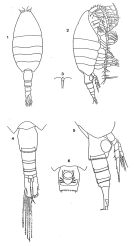 Female: 1, 2, habitus (dorsal view); issued from : Séret C., 1979. 2, habitus (lateral view); 3, Rostrum; 4, 5, Urosome (dorsal, lateral); 6, genital segment (ventral); issued from : Vervoort W. in Verh. K. ned. Akad. Wet., Afd. Natuurk., 1951, (2) 47 (2): 1-156.
|
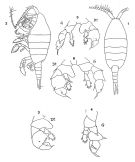 Male: 1, habitus (dorsal view); issued from : Séret, 1979. 2, habitus (lateral); 3, right P5; 4, left P5; issued from : Vervoort, 1951. 5, P5 (Dt: right, G: left); issued from : Tanaka O. in Spec. Publs. Seto mar. biol. Lab., 1960, 1-95. 6, P5 (Dt: right, G, left); issued from : Vervoort W. in Rep. B.A.N.Z. Antarctic Res. Exped., 1929-1931, 1957, B(3): 1-160.
|
 issued from : Vervoort W. in B.A.N.Z. Antarctic Research Expedition 1929-1931, 1957, B. 3. Copepods. [Fig.126]. As Heterorhabdus farrani. Male: P5 (rt: right, lt: left).
|
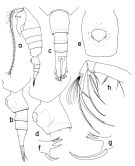 issued from : T. Park Bull. Scripps Inst. Oceanogr. Univ. California, San Diego, 2000, 31. [p.200, Fig.48].
Female: a, habitus (left side); b, c, urosome (left, dorsal, respectively); d, e, genital somite (left, ventral, respectively); f, masticatory edge of right Md (posterior); g, masticatory edge of left Md (posterior); h, left Mx2 (posterior)
|
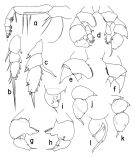 issued from : T. Park Bull. Scripps Inst. Oceanogr. Univ. California, San Diego, 2000, 31. [p.201, Fig.49].
Female: a, right Mxp (anterior); b, exopod of P1 (anterior); c, exopod of P5 (anterior).
Male: d, P5 (anterior); e, basipod of right P5 (anterior); f, basipod of left P5 (anterior); g, h, exopod of right P5 (anterior, posterior, respectively); i, distal exopodal segment of right P5 (posterior, tilted clockwise); j, distal exopodal segments of left P5 (anterior); k, exopod of left P5 (anterior); l, distal exopodal segment of left P5 (posterior).
|
 issued from : W. Vervoort in B.A.N.Z. Antarctic Reseach Expedition, Report Ser. B, Vol. III. Copepods. 1957 [Fig.126]. Male (from 61°44'S, 77°59'E): P5.
|
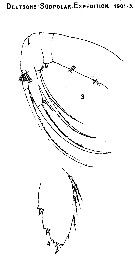 issued from : R.N. Wolfenden in Die Marinen Copepoden der Deutschen Südpolar-Expedition 1901-1903, 1911. [Pl.XXXV, Figs.3-4]. As Alloiorhabdus austrinus. Female: 3, Mx2; 4, P3 (distal segment of exopod).
|
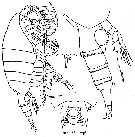 issued from : W. Vervoort in Verh. K. ned. Akad. Wet., Afd. Natuurk., 1951, (Sect. 2) 47 (2). [p.130, Fig.70]. As Heterorhabdus farrani. Female (from ± 66°.5S, 11°W): a, habitus (lateral); b, posterior part cephalothorax, right P5 and urosome (lateral); c, rostrum (ventral); d, genital somite (ventral). Nota : Head carrying a rounded, slightly protruding frontal organ, which has 2 slender, filiform rostral appendages, hidden between the basal parts of A1 ; epistoma much produced and distinctly visible between the oral appendages. Head and 1st thoracic somite separated, 4th and 5th fused. Cephalothorax ovoide. Proportional lengths of cephalothorax and abdomen as 53 :27. Abdomen 4-segmented, the distal borders of the first three abdominal somites have a fringe of very distinct, triangular spines ; anal segment and caudal rami indistinctly separated, especially on the left side ; proportional lengths of the abdominal segments and the left caudal ramus 36 :17 :12 :6 :29 = 100. Caudal rami asymmetrical, the left ramus slightly larger than the right ; each caudal ramus with 4 marginal setae, 1 short internal seta and 1 strong outer edge seta, placed at half the length of the ramus. ; internal margin of caudal rami haired on the distal part. Anal operculum indistinct.
|
 issued from : W. Vervoort in Verh. K. ned. Akad. Wet., Afd. Natuurk., 1951, (Sect. 2) 47 (2). [p.132, Fig.71]. As Heterorhabdus farrani. Female: a, habitus (dorsal); b, urosome (dorsal); c, forehead (lateral from left side after removal of the oral appendages and antennae. Nota: The prosome shows in the drawing 5 lines of separation, contrary to the description in which the cephalon and the 1st thoracic somite are separated, but the 4th and 5th thoracic somites are fused.
|
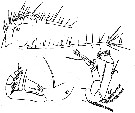 issued from : W. Vervoort in Verh. K. ned. Akad. Wet., Afd. Natuurk., 1951, (Sect. 2) 47 (2). [p.133, Fig.72]. As Heterorhabdus farrani. Female: a-b, right A1 (the numbers 14 and 15 indicate the 14th and 15th segments); c, right Mxp; d, left A2. Nota: A1 25-segmented. Endopod of A2 very slightly shorter than the exopod. Mx1 : 1st inner lobe elongate, with 12 spiniform setae, which appear to be only slightly chitinized and occasionally haired ; 2nd inner lobe with a strong seta ; 3rd inner lobe absent ; 1st outer lobe small, almost obliterated, with 5 setae ; no 2nd outer lobe ; 2nd basal segment with 1 plumose seta ; exopod styliform, much elongated, at the apex with 5 setae ; endopod with 5 small setae. Mx2 with 6 lobes and endopod very small, indistinctly segmented, with 7 thin, nude setae in all. Mxp with 2 basal segments, the 2nd with 2 tubercles on the distal portion which appear to contain the apertures of glands ; endopod small with 5 segments, the 5th with 4 setae, one of which is very small.
|
 issued from : W. Vervoort in Verh. K. ned. Akad. Wet., Afd. Natuurk., 1951, (Sect. 2) 47 (2). [p.134, Fig.73]. As Heterorhabdus farrani. Female: left Md.
|
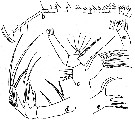 issued from : W. Vervoort in Verh. K. ned. Akad. Wet., Afd. Natuurk., 1951, (Sect. 2) 47 (2). [p.135, Fig.74]. As Heterorhabdus farrani. Female: c, left Mx1; d, right Mx2; e, right Md (cutting edge). Male: a-b, left A1 (the numbers 5 and 6 indicate the 5th and 6th segments).
|
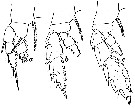 issued from : W. Vervoort in Verh. K. ned. Akad. Wet., Afd. Natuurk., 1951, (Sect. 2) 47 (2). [p.136, Fig.75]. As Heterorhabdus farrani. Female: a-c, P1 to P3 (right feet; anterior aspect). Nota: Anterior surface of the 3rd exopodal segment of P3 with a large number of pores : 1- circular spots, representing the opening of a gland ; 2- pitted or granulated, circular areas, apparently representing the apertures of various glands or other ducts ; 3- semicircular slits, which appear to have no connection with glands or other ducts.
|
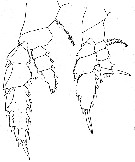 issued from : W. Vervoort in Verh. K. ned. Akad. Wet., Afd. Natuurk., 1951, (Sect. 2) 47 (2). [p.137, Fig.76]. As Heterorhabdus farrani. Female: a, right P4 (anterior); b, right P5 (anterior).
|
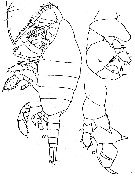 issued from : W. Vervoort in Verh. K. ned. Akad. Wet., Afd. Natuurk., 1951, (Sect. 2) 47 (2). [p.139, Fig.77]. As Heterorhabdus farrani. Male: habitus (lateral); b, right P5 (anterior); c, left P5 (anterior). Nota : Proportional lengths of cephalothorax and abdomen as 53 :25. Proportional lengths of the four first abdominal segments and the 5th plus the left caudal ramus 17 :16 :16 :13 :38 = 100. The left caudal ramus is indistinctly separated from the anal segment. Left A1 21-segmented with a clasping organ (1st and 2nd segments fused, 19th-21st and 22nd-23rd fused).
|
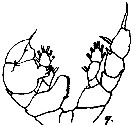 issued from : R.N. Wolfenden in Plankton Studies Part I. Copepoda. 1905 [Pl. IV, 9]. As Heterorhabdus austrinus. Male: 9, P5.
|
 Paraheterorhabdus (Paraheterorhabdus) farrani Paraheterorhabdus (Paraheterorhabdus) farrani female: 1 - Left caudal ramus distinctly longer than right and completely fused with anal segment (Fig.48-c) 2 - Dorsally, posterolateral corners of prosome angular (Fig.48-b). 3 - Laterally, 2nd urosomal somite (Fig.48-b) with a swelling along ventral margin.
|
 Paraheterorhabdus (Paraheterorhabdus) farrani Paraheterorhabdus (Paraheterorhabdus) farrani female: 1 - Left caudal ramus distinctly longer than right and completely fused with anal segment; setation in both rami as in female (Fig.48-c). 2 - Basis of right P5 with conical inner lobe (Fig.49-e). 3 - P5 with very thick exopods (Fig.49-d); medial projection of 2nd exopodal segment of right P5 (Fig.49-g) with a lobe on distal side.
|
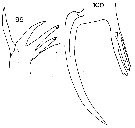 Issued from : J.M. Bradford in N.Z. Oceanogr. Inst., 1971, 206, Part 8, No 59. [p.25, Figs.99-100]. As Heterorhabdus farrani. Female (from 75°09'S, 171°00'W): 99, right Md (gnathobase edge); 100, left Md (gnathobase edge). Scale bar: 100 µm.
|
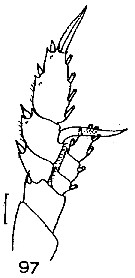 Issued from : J.M. Bradford in N.Z. Oceanogr. Inst., 1971, 206, Part 8, No 59. [p.24, Fig.97]. As Heterorhabdus farrani. Female (from Ross Sea): 97, P5. : 100 µm.
|
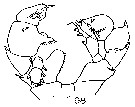 Issued from : J.M. Bradford in N.Z. Oceanogr. Inst., 1971, 206, Part 8, No 59. [p.24, Fig.98]. As Heterorhabdus farrani. Male (from Ross Sea): 98, P5 Scale bar: 100 µm.
|
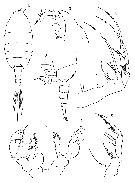 Issued from : O. Tanaka in Spec. Publs. Seto mar. biol. Lab., 10, 1960 [Pl. XXIII]. Male (from 67°04'S, 40°53'E): 1, habitus (dorsal); 2, head (lateral); 3, last thoracic segment and abdomen (lateral); 4, Mx2; 5, Mxp; 6, P5. figs.4, 5 and 6 at the same scale. Nota: Cephalothorax and abdomen in the proportional lengths 68 to 32. Frontal organ slightly produced, to which 2 slender rostral filaments are attaced. The head in lateral view has a distinct constriction opposite to the oral part. Postero-lateral thoracic margin rounded in lateral view, and in dorsal view obtusely pointed. Abdominal segment 5-segmented; segments and caudal rami in the proportional lengths 19 : 16 : 15 : 13 : 6+31 = 100. The right caudal ramus with the 2nd and 3rd internal setae furnished, beside usual fine hairs, with small spines along each side of the setae. Left A1 transformed into a clasping organ. Remarks : The author had obtained several specimens of robustus both female and male from the Izu region; on comparing the present antarctic male with that of robustus it is clearly distinct from robustus. They differ each other in the shape of P5, the 3rd segment of the right P5 of farrani is different in the proportional length from that of robustus, and also in the characteristic long spine on the inner margin of the exopodal segment of the left leg.
|
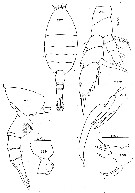 Issued from : C. Séret in Thesis 3ème Cycle, UPMC, Paris 6. 1979 [Pl. XXXIX, Figs.257-262]. As Heterorhabdus farrani. Female (from off Kerguelen Is.): 257, habitus (dorsal); 258, last thoracic segment and urosome; 259, last thoracic segment and genital segment (other indivividual); 260, right Md (biting edge of gnathobase); 261, left Md (biting edge of gnathobase); 262, P5.
|
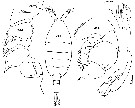 Issued from : C. Séret in Thesis 3ème Cycle, UPMC, Paris 6. 1979 [Pl. XL, Figs.263-267]. As Heterorhabdus farrani. Male: 263, habitus (dorsal); 264, left P5; 265, right P5; 266, right Md (biting edge of gnathobade); 267, left Md (biting edge of gnathobase).
|
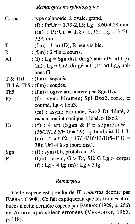 Issued from : C. Razouls in Ann. Inst. océanogr., Paris, 1994, 70 (1). [p.162]. As Heterorhabdus compactus. Caractéristiques morphologiques de Paraheterorhabdus farrani femelle et mâle adultes. Terminologie et abbréviations: voir à Calanus propinquus.
| | | | | Ref. compl.: | | | Park & Ferrari, 2009 (p.143, Table 3, 8, figs.1, 2, Appendix 1, biogeography) | | | | NZ: | 7 | | |
|
Carte de distribution de Paraheterorhabdus (Paraheterorhabdus) farrani par zones géographiques
|
| | | | | | | | |  Issued from : E.T. Park & F.D. Ferrari in A selection from Smithsonian at the Poles Contributions to International Polar year. I. Krupnik, M.A. Lang and S.E. Miller, eds., Publs. by Smithsonian Institution Scholarly Press, Washington DC., 2009. [p.167, Fig.2]. Issued from : E.T. Park & F.D. Ferrari in A selection from Smithsonian at the Poles Contributions to International Polar year. I. Krupnik, M.A. Lang and S.E. Miller, eds., Publs. by Smithsonian Institution Scholarly Press, Washington DC., 2009. [p.167, Fig.2].
Distribution of selected pelagic calanoids Paraheterorhabdus farrani of the Southern Ocean and the closest relative in the subarctic region of the Arctic Ocean. |
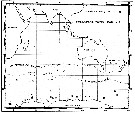 Issued from : C. Séret in Thesis 3ème Cycle, UPMC, Paris 6. 1979, Annexe. [p.50]. Issued from : C. Séret in Thesis 3ème Cycle, UPMC, Paris 6. 1979, Annexe. [p.50].
Geographical occurrences of Heterorhabdus farrani (= Paraheterorhabdbdus farrani) in the Indian Ocean and Antarctic zone. [after publications from: Brady, 1883, 1918; Thompson, 1900; Wolfenden, 1908, 1911; With , 1915; Rosendorn, 1917; Farran, 1929; Sewell, 1929, 1947; Brady & Gunther, 1935; Steuer, 1929, 1392, 1933; Ommaney, 1936; Vervoort, 1957; Tanaka, 1960; Brodsky, 1964; Seno, 1966; Andrews, 1966; Grice & Hulsemann, 1967; Seno, 1966; Frost & Fleminger, 1968; Voronina, 1970; Zverva, 1972].
Nota: C. Séret notes the occurrence at station 56°S, 70°E. |
| | | | Loc: | | | Antarct. (Peninsula, Weddell Sea, SE Atlant., Indian, SW Pacif., Drake Passage), sub-Antarct. (South Georgia, Indian, Kerguelen Is., SW & SE Pacif., Drake Passage), Indian (SW subtropical convergence), off W South Africa, off NW Tristan da Cunha, SW Indian, S Chile, S Tasmania, New Zealand (E South Island), off S New Zealand (convergence antarctic)
Type locality: 64°34'S, 127°08'E & 64°34'S, 117°01'E | | | | N: | 28 | | | | Lg.: | | | (10) F: 4,35; M: 4; (25) F: 4,28-3,6; M: 3,96-3,51; (31) F: 4,15-3,95; M: 3,94-3,85; (35) F: 3,65; (66) M: 3,8; (102) F: 3,8; M: 3,6; (246) F: 4,25-3,69; M: 3,87-3,61; (824) F: 4,24-3,52; M: 3,92-3,4; (909) M: 3,5; 3,6; {F: 3,52-4,35; M: 3,40-4,00} | | | | Rem.: | bathypélagique.
H. farrani ressemble fortement à H. robustus Farran, 1908. En 1965, Vervoort affirme que ces deux espèces sont différentes ''les segments abdominaux sont garnis distalement d'une frange de spinules chez H. farrani'' tandis que ceux chez H. robustus sont à peu près nus''. Or, les segments chez H. robustus figurés par Tanaka (1964) portent une frange de spinules.
Espèce caractéristique des eaux purement antarctiques. Ses effectifs deviennent très faible au nord de la convergence antractique. Dans le Paxifique sud-est, elle remonte jusq'au 40°46' Sud (Bjornberg, 1973). Espèce des eaux froides qui supporte des températures allant de - 0,72°C à + 1,15°C. | | | Dernière mise à jour : 29/01/2017 | |
|
|
 Toute utilisation de ce site pour une publication sera mentionnée avec la référence suivante : Toute utilisation de ce site pour une publication sera mentionnée avec la référence suivante :
Razouls C., Desreumaux N., Kouwenberg J. et de Bovée F., 2005-2025. - Biodiversité des Copépodes planctoniques marins (morphologie, répartition géographique et données biologiques). Sorbonne Université, CNRS. Disponible sur http://copepodes.obs-banyuls.fr [Accédé le 13 septembre 2025] © copyright 2005-2025 Sorbonne Université, CNRS
|
|
 |
 |



























